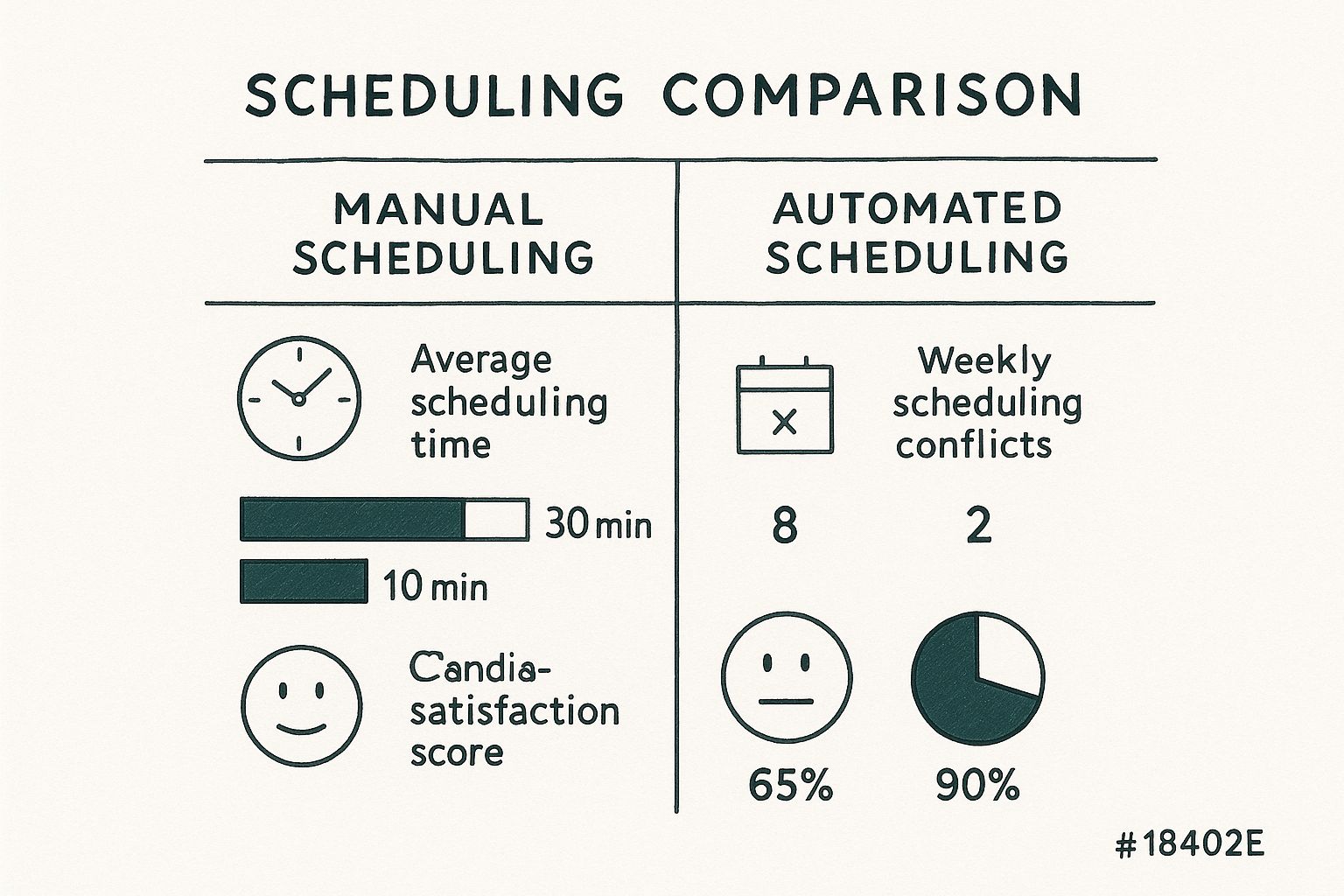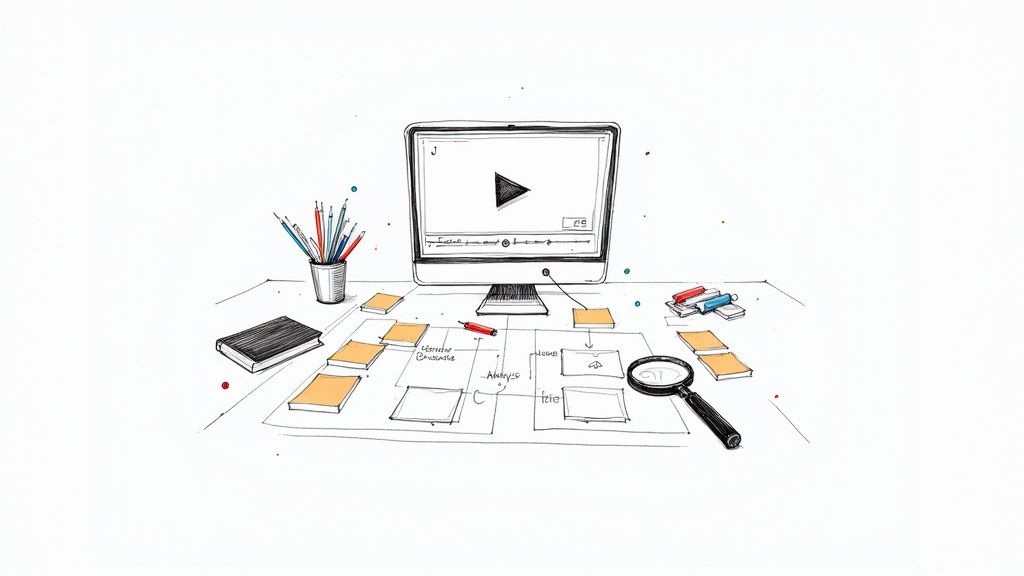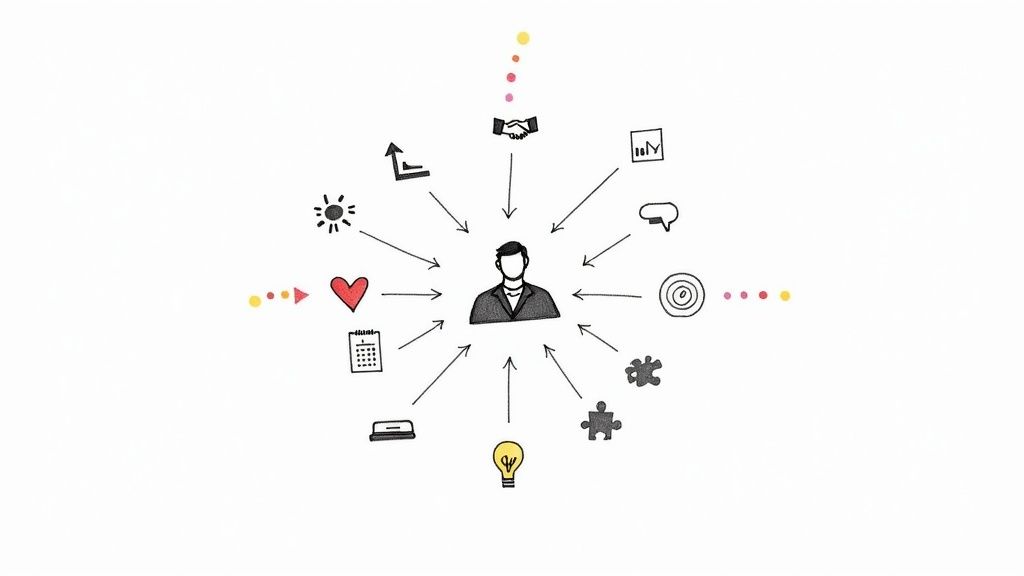If you want to boost your recruiting efficiency, you can't just throw money at the problem or tell your team to work faster. You have to get to the root of what's slowing you down. It's about diagnosing the real bottlenecks in your pipeline and then matching a clear strategy with the right technology.
This isn’t about just speeding things up; it’s about building a modern hiring engine that consistently attracts top talent and stops costly delays before they start.
Building a Foundation for Efficient Recruiting

Before you can fix a slow or broken hiring process, you have to be honest about where the cracks are. Too many teams jump straight to solutions—buying a new tool, posting on more job boards—without first figuring out what’s actually wrong. This approach is a recipe for wasted money and lingering frustration.
Real efficiency isn't about speed for the sake of speed. It’s about building a predictable, repeatable, and effective system for finding and hiring great people.
Many of these ideas come from broader strategies focused on improving overall business efficiency. The core principle is identical: identify waste, streamline workflows, and measure what actually matters. In recruiting, this waste shows up as time spent on unqualified candidates, endless back-and-forth scheduling emails, or poor communication that causes your best applicants to walk away.
The Modern Recruiting Imperative
Today's talent market is unforgiving. There’s no room for slow, clunky hiring processes. In fact, for 2025, 42% of companies say intense competition for talent is one of their biggest hiring challenges. This means your best candidates have other offers on the table, and they won’t wait around for you to get organized.
This reality has pushed organizations to invest heavily in their hiring infrastructure. Nearly 93% of companies are expected to put money into recruitment technology this year, a clear signal that manual, outdated processes just don't cut it anymore. Compounding the issue, an estimated 51% of organizations are dealing with high turnover within their own recruiting teams, which only makes existing problems worse.
A strong foundation for recruiting efficiency rests on three core pillars: a clear strategy, a smart technology stack, and an unforgettable candidate experience. If you neglect any one of these, you'll undermine your efforts to build a truly modern hiring function.
Pinpointing Your Inefficiencies
To get started, you need to take a hard look at where your process is failing. Are you drowning in irrelevant resumes? Is interview scheduling a logistical nightmare? Is critical feedback getting lost between recruiters and hiring managers? Answering these questions means you have to get in the weeds of your current workflow.
Below is a look at some of the most common bottlenecks we see and how modern solutions can address them head-on.
Common Inefficiencies and Their Modern Solutions
This table breaks down some of the most frequent friction points in the recruiting pipeline. More importantly, it outlines strategic, technology-driven solutions you can implement to solve them.
| Common Inefficiency | Impact on Recruiting | Modern Solution |
|---|---|---|
| Manual Resume Screening | Wastes dozens of hours on unqualified applicants and increases the risk of overlooking top talent. | Use an ATS with AI-powered screening to automatically surface the most relevant candidates based on skills and experience. |
| Chaotic Interview Scheduling | Causes significant delays, frustrates candidates, and consumes valuable recruiter and manager time. | Implement automated scheduling tools or asynchronous interviews to eliminate back-and-forth emails. |
| Inconsistent Feedback | Leads to subjective, biased decisions and a lack of clear criteria for what makes a good hire. | Create standardized interview scorecards and a centralized platform for collaborative feedback. |
| Poor Candidate Communication | Results in high drop-off rates, damages your employer brand, and creates a negative experience for applicants. | Set up automated email sequences to keep candidates informed at every stage, from application to rejection. |
By systematically identifying and fixing these friction points, you can transform your recruiting process from a reactive, chaotic function into a strategic advantage for your company. This foundational work is what sets the stage for every other improvement you’ll make.
Using Technology to Find Better Candidates Faster

If you're only using your Applicant Tracking System (ATS) as a digital filing cabinet, you're missing the point entirely. It's one of the biggest missed opportunities I see in recruiting. The real magic happens when you transform your ATS from a passive database into an active, intelligent sourcing engine that helps you find and engage top talent before your competitors even post a job.
This isn’t about just tracking applicants. It’s about letting technology handle the grunt work that bogs down your team.
Think about it: you can set up automation rules that instantly tag promising candidates from past searches for future roles. Maybe a great software developer applied for a senior position last year but wasn't quite the right fit then. With smart tagging, your ATS can automatically surface their profile the moment a new, more suitable mid-level spot opens up. Suddenly, your existing database becomes a warm talent pipeline.
Uncovering Talent With AI and Automation
Modern recruiting isn't a passive game of post-and-pray. It’s about proactively hunting for the best people, many of whom aren't even looking for a new job. This is where AI-powered sourcing tools have become a recruiter's best friend. They scan professional networks, niche online communities, and other platforms to pinpoint passive candidates who fit your ideal profile but would never have seen your job ad.
Agencies have been leaning into these tools for a while now to boost their own efficiency. And the numbers back it up: 86% of recruiters say AI-driven tools make their process significantly better, and some have cut their time-to-hire by up to 70%. This shift also involves a massive reliance on social media, with 94% of recruiters using platforms like LinkedIn as a primary hunting ground.
Practical Steps for Smarter Sourcing
Putting technology to work doesn't require a massive, expensive overhaul. You can start with small, high-impact changes that make a real difference.
- Apply SEO to Job Descriptions: Start treating your job descriptions like web pages. Use keywords your ideal candidates are actually searching for. Your internal title might be "Growth Hacker," but they're likely searching for terms like "B2B SaaS marketing."
- Automate LinkedIn Searches: Use the saved search and alert features in LinkedIn Recruiter. Set up highly specific searches for your key roles and get daily or weekly emails packed with new candidates who fit your criteria.
- Use Browser Extensions: Tools like HireEZ or Lusha are fantastic for finding contact information for promising candidates right from their social profiles. This makes your outreach faster, more direct, and way more effective.
These simple tactics can help you build a solid pipeline without adding hours of manual work to your day. Let technology handle the volume so you can focus on what really matters: building relationships.
The most efficient recruiting teams don't just use technology; they build systems around it. They have a process for how they source, how they tag, and how they re-engage candidates over time.
To really get ahead, it's worth exploring how AI hiring and intelligent assessment are changing the game in talent evaluation. It's one thing to find candidates, but integrating these tools helps you find the right ones.
Once you’ve built this tech-powered sourcing machine, you've got a new challenge: a steady stream of great candidates. Now you need an efficient way to screen them without creating a scheduling nightmare. A powerful next step is to modernize your recruitment process with on-demand asynchronous interviews. This approach lets you screen far more candidates in less time, dramatically speeding up your entire hiring workflow.
Overhauling Your Interview and Selection Workflow
The interview stage is where all your hard work can grind to a halt. It’s a classic bottleneck, often bogged down by a messy tangle of back-and-forth emails, calendar conflicts, and subjective feedback that slows everything to a crawl. The truth is, getting efficient with recruiting isn't just about finding people faster; it’s about moving the right people through your process with clarity and momentum.
Think about it. Every manual scheduling attempt, every unstructured "tell me about yourself" chat, and every delayed piece of feedback adds friction. This friction doesn't just waste your team's time—it creates a frustrating experience that can send your best applicants straight to competitors who know how to move decisively.
Embrace Asynchronous Interviews for Initial Screening
One of the biggest time-sucks in the early stages is coordinating schedules for initial phone screens. Chasing down 10 candidates can feel like a full-time job of calendar Tetris and unanswered emails. This is where asynchronous video interviews can be a total game-changer.
Instead of a live call, you send candidates a link with a few pre-set questions. They record their answers on their own time, and your hiring team can review the responses whenever it’s convenient. Just like that, the scheduling nightmare disappears.
You'll find you can screen five times more candidates in the time it used to take for just a handful of live calls. This allows your team to evaluate a much wider, more diverse talent pool without getting buried in administrative busywork.
The real power of asynchronous interviews is the time they give back to everyone. Candidates can present themselves thoughtfully without the pressure of a live call, and recruiters can finally focus on high-value activities, like engaging top prospects, instead of just managing calendars.
When it comes to the interview process, you have several options, each with its own pros and cons. Let's break down how they stack up.
Comparing Interview Methods for Efficiency
| Interview Method | Time Commitment | Candidate Experience | Best For |
|---|---|---|---|
| Traditional Phone Screen | High (for recruiter and candidate) | Inconsistent; high chance of no-shows | Quick, live qualification if schedules align easily. |
| Live Video Interview | High (for all parties) | Good, but scheduling can be a major pain point. | Mid-to-late stage interviews requiring real-time interaction. |
| Asynchronous Interview | Low (for recruiter), Moderate (for candidate) | Excellent flexibility; less pressure for candidates. | Initial screening, assessing communication skills, and handling high volume. |
| In-Person Interview | Very High (for all parties) | Highest touch, but logistical and costly. | Final-stage interviews, assessing team fit, and making the final offer. |
As you can see, choosing the right method for the right stage is key. Using asynchronous interviews at the top of the funnel frees up valuable time for more in-depth, high-touch methods later on.
Standardize Your Approach With Structured Interviews
Once you’ve moved past the initial screen, consistency becomes your best friend. Those unstructured, "go-with-the-flow" interviews are notorious for letting unconscious bias creep in and producing wildly inconsistent feedback. You know the drill: one interviewer focuses on personality, another grills on a niche technical skill, and you’re left trying to compare apples and oranges.
A structured interview process is the antidote. It’s pretty straightforward:
- Use Competency-Based Questions: Every single candidate for a role gets asked the same core set of questions. These aren't random—they're tied directly to the skills needed for the job. For a sales role, you might ask about handling objections or managing a pipeline.
- Create Interview Kits: Make it easy for your hiring managers. Give them a simple kit for each interview that includes the job description, the candidate’s resume, your list of structured questions, and a standardized scorecard.
This approach ensures every candidate is measured against the same fair and relevant criteria. It not only reduces bias but also forces a much-needed conversation about what truly matters for someone to succeed in the role, leading to far better hiring decisions.

As this data shows, moving from manual to more automated and structured processes has a massive impact. It cuts down on administrative time, reduces conflicts, and gives a huge boost to your candidate satisfaction scores.
Simplify Feedback With Standardized Scorecards
How many times have you gotten feedback like, "I just didn't get a good vibe," or "they weren't a culture fit"? That kind of vague input is completely useless. It doesn't help you make a decision, and it certainly doesn't help you refine your process.
To fix this, you need to standardize how your team captures and shares interview feedback.
The best way to do this is with simple scorecards, ideally built right into your Applicant Tracking System (ATS). You don't need some overly engineered system. Just take the core competencies for the role and create a simple 1-5 rating scale for each, with a spot for brief comments.
Here’s a practical example for a Project Manager role:
| Competency | Rating (1-5) | Comments |
|---|---|---|
| Client Communication | 4 | Provided clear, concise examples of managing client expectations. |
| Risk Management | 3 | Understood the concept but struggled with specific mitigation tactics. |
| Team Leadership | 5 | Excellent examples of motivating a team through a difficult project. |
Using a simple table like this creates a centralized, comparable record for every candidate. It holds interviewers accountable for their assessments and dramatically shrinks the time it takes to go from the final interview to making a confident offer.
Crafting a Candidate Experience That Keeps People Engaged
A slow, confusing, or impersonal hiring process is more than just a minor headache; it's a direct leak in your talent pipeline. Your top candidates are interviewing you just as much as you're interviewing them. Every confusing application form, unacknowledged email, and delayed update gives them a reason to say "yes" to another company.
Improving the candidate journey isn't a "nice-to-have"—it's a core strategy for locking in great hires and preventing inefficiency.
The frustrating reality is that candidate ghosting and drop-offs are at an all-time high. A recent report found that a staggering 46% of employers struggle with candidates ghosting them during the hiring process. This isn't just bad luck; it's a direct result of a market where job seekers have more options, making them far less tolerant of a clunky experience. To get a better sense of these workforce challenges, you can explore the full findings on recruiting statistics.
Simply put, the "black hole" where applications go to die is no longer acceptable. A thoughtful, human-centric candidate experience is your best defense against losing the people you want to hire.
Map the Entire Candidate Journey
To fix the experience, you first have to see it through a candidate's eyes. Don't just assume you know what it's like—actually go through it yourself.
- Apply for Your Own Job: Grab a test email and resume and see what happens. How long does it take? Is it a nightmare on mobile? Are there any bizarre or repetitive fields?
- Document Every Single Touchpoint: Make a list of every interaction a candidate has, from the moment they see the job ad to the final decision. This includes automated emails, scheduling links, interviews, and even rejection notices.
- Find the Gaps: Where are the long silences? Pinpoint the moments a candidate is most likely to feel uncertain or forgotten. Is it the week after they apply? The days following their final interview?
This simple audit will instantly show you the friction points that are costing you talent. You'll likely spot communication gaps you never even knew existed.
Over-Communicate (The Right Way)
Silence is the number one reason candidates lose interest. They interpret a lack of communication as disorganization or, even worse, a lack of respect for their time. The solution is to be proactive, even when you have nothing new to share.
"Your recruiting process is a direct reflection of your company's culture and operational excellence. A candidate who feels valued and informed, even when receiving a rejection, is far more likely to reapply in the future or recommend your company to their network."
Building a communication plan is critical. You can set up simple, automated email workflows in your Applicant Tracking System (ATS) to handle key stages. A quick "Thanks for applying, we'll review applications by [Date]" email sets an immediate positive tone. Later on, a follow-up that says, "We're still reviewing candidates and will have an update for you next week," can be the one thing that prevents your top choice from accepting another offer.
To make your process even stronger, our guide on how to improve your candidate experience offers additional templates and strategies you can implement today.
Turn Rejection Into a Positive Touchpoint
Most companies handle rejections poorly, if they handle them at all. This is a massive missed opportunity. A well-crafted rejection can preserve your employer brand and keep the door open for future roles.
Forget the generic, cold "we've decided to move forward with other candidates" email. Instead, offer something of value.
- Be Timely: Don't leave candidates hanging for weeks just to hear a "no." Send the update as soon as the decision is final.
- Be Human: A little empathy goes a long way. Take a moment to acknowledge the time and effort they invested in your process.
- Provide an Outlet: If you can, briefly explain why they weren't a fit. For high-value candidates, a quick, personalized note from the hiring manager can make a world of difference.
Every single interaction shapes your reputation. By treating all applicants with respect—even the ones you don't hire—you build a talent pipeline and a brand that attracts the very best people.
Tracking the Metrics That Actually Matter

You can't fix what you can't see. To really get a handle on your recruiting efficiency, you have to move beyond gut feelings and start looking at the hard data. But this isn't about tracking every single number you can get your hands on. The real trick is cutting through the noise of vanity metrics to focus on the Key Performance Indicators (KPIs) that tell the true story of your hiring engine.
Too many teams get bogged down tracking things like the total number of applications. Let’s be honest, a mountain of applications is useless if none of them are qualified. Instead, a data-driven approach helps you diagnose the real bottlenecks in your process and, just as importantly, prove your team's value to leadership.
The Big Four Recruiting Metrics
To build a clear picture of your performance, start with these four foundational metrics. They work together to give you a complete view of your recruiting function's speed, cost, and effectiveness. Think of them as the vital signs for your talent acquisition health.
- Time to Fill: This is the total number of days from when a job req is opened until an offer is accepted. It’s your primary indicator of speed and overall efficiency.
- Cost per Hire: This one is simple: the total internal and external costs tied to filling a role, divided by the number of hires. It’s the ultimate measure of your financial efficiency.
- Quality of Hire: Often tracked through a new hire's performance reviews, ramp-up time, or retention after one year. This metric answers the most critical question: are we actually hiring the right people?
- Source of Hire: This shows where your successful candidates are coming from (e.g., your careers page, referrals, LinkedIn). It tells you exactly where to invest your sourcing time and money.
By zeroing in on these four, you can build a simple but powerful dashboard that shifts you from reactive problem-solving to proactive, strategic planning.
Going Beyond the Numbers
Just calculating a metric isn't enough. The real value comes from digging into what it’s telling you. A high Time to Fill isn't just a number—it’s a symptom of a deeper problem. Your job is to play detective and figure out the root cause.
For example, is your Time to Fill for engineering roles consistently creeping over 60 days? This could signal a few different issues:
- Your job descriptions might be unclear or packed with unrealistic expectations.
- The interview process could be too long or disorganized, causing top candidates to drop out.
- Your compensation benchmark might be way too low for the current market.
By segmenting your data—by department, role, or even hiring manager—you can pinpoint exactly where the process is breaking down. A consistently slow hiring manager might need more training on how to conduct effective interviews, while a high drop-off rate after the first interview could mean your initial screen isn't aligned with what the team actually needs.
Don’t treat metrics as just numbers on a report. Use them as conversation starters. A high Cost per Hire isn't a failure; it’s an opportunity to have a data-backed discussion with finance about investing in a better referral program or a more effective sourcing tool.
Building Your Recruiting Dashboard
To make this practical, you don’t need fancy, complex software. You can get started with a simple spreadsheet or just use the reporting features already in your Applicant Tracking System (ATS). For a deeper dive, our guide on the 8 essential recruitment KPIs to track in 2025 provides more detail on how to set up and interpret these metrics.
The goal here is to create a living dashboard that empowers you to have data-driven conversations. When you can walk into a meeting and say, "Our referral program consistently delivers the best Quality of Hire and the lowest Cost per Hire," you're no longer just a recruiter; you're a strategic business partner.
Common Questions About Recruiting Efficiency
As you start dialing in your recruiting process, you’re bound to run into some practical questions. It's one thing to talk about theories and metrics, but applying them in the real world is where the rubber meets the road. Let's tackle a few of the most common hurdles teams face.
How Can Small Businesses Improve Efficiency on a Budget?
You don't need a massive budget to build a killer recruiting machine. For small businesses, it’s not about outspending the competition; it’s about being more resourceful and strategic. The secret lies in maximizing free and low-cost tools while building an authentic employer brand that money simply can't buy.
Start by getting smart with your job descriptions. Think like a candidate: what search terms would they actually type into a job board to find a role like yours? Weave those keywords into your job title and description. This simple SEO trick can pull in a surprising number of inbound applicants without you ever paying for a sponsored post.
From there, tap into your local community.
- Get active in local social media groups. Don't just post jobs—talk about what makes your company a great place to work.
- Set up a simple referral program. A small, meaningful bonus for current employees who refer a successful hire goes a long way.
- Show up at community events. Real, face-to-face conversations build a powerful local reputation that attracts talent organically.
These efforts cost next to nothing but create a sustainable pipeline of candidates who are genuinely excited about your company, not just any old job.
What’s the First Step When Time to Hire Is Too Long?
When your time-to-hire starts to balloon, it's tempting to point fingers at slow hiring managers or a weak talent pipeline. But often, the real culprit is hiding somewhere else entirely. Before you jump to solutions, your absolute first step should be a bottleneck audit to find out where the biggest delays are really happening.
A high time-to-hire is a symptom, not the disease. Jumping to a solution without a proper diagnosis is like taking medicine for the wrong illness—it won’t work, and it might even make things worse.
To run an audit, map out every stage of your hiring process. Then, measure the average time it takes for a candidate to get from one stage to the next.
Example Bottleneck Analysis
| Stage | Average Time (Days) | What This Might Mean |
|---|---|---|
| Application to First Review | 10 | Your recruiting team is probably drowning in manual screening. |
| First Review to Interview | 14 | Scheduling is a nightmare of back-and-forth emails. |
| Interview to Final Decision | 3 | The feedback loop is working great. |
In this scenario, the data screams that the problems are screening and scheduling. This tells you exactly where to focus. Instead of nagging the hiring manager for faster decisions, you’d be better off implementing an AI screening tool or using asynchronous interviews to fix the actual logjam.
How Does Better Efficiency Affect Employee Retention?
Improving recruiting efficiency isn't just about saving time and money—it has a direct and powerful impact on whether your new hires stick around. The logic is simple: a positive, streamlined, and respectful hiring process sets the tone for a new hire’s entire experience with your company.
Think of your hiring process as the opening chapter of the employee story. When a candidate experiences clear communication, timely updates, and a well-organized interview, they feel valued from day one. That positive first impression builds an immediate foundation of trust and respect.
On the flip side, a chaotic, slow, or impersonal process sends a clear signal that the company is disorganized or doesn't care about its people. That bad taste is hard to wash out and can lead to a new hire feeling disengaged or having second thoughts before their first day. By creating a great candidate experience, you're not just filling a role—you're starting a relationship built to last, which boosts loyalty and slashes costly first-year turnover.
Ready to eliminate scheduling bottlenecks and screen candidates 10x faster? Async Interview automates your initial screening with on-demand video interviews, giving you the time back to focus on building relationships with top talent. Start your free trial and see how it works.




